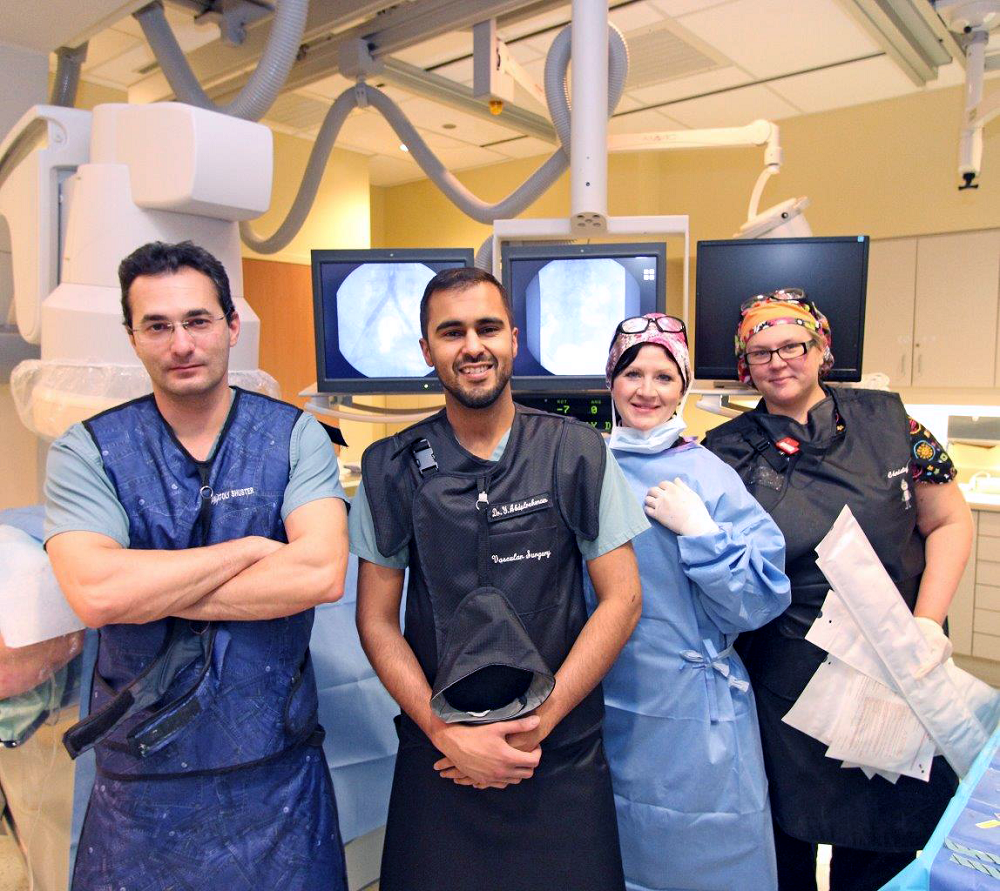New vascular services at TBRHSC already producing dramatic results
by Chisholm Pothier
 Members of the team after a recent kissing stents procedure. From left, Dr. Anatoly Shuster, Interventional Radiologist, Dr. Yaasin Abdulrehman, Vascular Surgeon, Rebecca Smith, Medical Radiation Technologist and Christy Lactu, Medical Radiation Technologist.
Members of the team after a recent kissing stents procedure. From left, Dr. Anatoly Shuster, Interventional Radiologist, Dr. Yaasin Abdulrehman, Vascular Surgeon, Rebecca Smith, Medical Radiation Technologist and Christy Lactu, Medical Radiation Technologist.People in Northwestern Ontario lose their limbs to amputation at a rate 2.7 times greater than the provincial average.
Many of these amputations would not have been necessary if the patient had received appropriate care sooner. But a historic lack of cardiovascular services in this part of the province has contributed to the much higher loss of limbs found among patients here.
The introduction of Cardiovascular Services at Thunder Bay Regional Health Sciences Centre, endorsed by the provincial government last June, will have a dramatic impact on reversing this inequity and saving limbs for people in Northwestern Ontario that otherwise would have lost them.
It has already likely saved at least one.
Gaetanne Roy of Nakina feels lucky to still have all her limbs. She was the recipient of one of the first bilateral aortoiliac kissing stent insertion procedures performed at TBRHSC in its history. The procedure was done by vascular surgeon Yaasin Abdulrehman and vascular interventional radiologist Anatoly Shuster. It was only because the hospital had recruited these two specialists as part of its first steps towards a cardiovascular service that the procedure was able to be performed here.
For Ms. Roy, the benefit cannot be overstated.
“Thunder Bay saved my leg,” she states unequivocally.
Ms. Roy’s was a complicated case. She is diabetic and has a transplanted kidney. She was suffering from severe vascular disease, resulting in dramatic narrowing and blocking of arteries pumping blood to her legs and feet. She had developed ulcers on her foot. Her nephrologist Dr. Paul Watson referred her to Dr. Abdulrehman, concerned she was in danger of losing her limb.
She was indeed. With the tissue loss from her condition, Ms. Roy had a 40 per cent chance of losing her leg within six months if her circulation wasn’t improved, said Dr. Abdulrehman.
“She certainly was high risk,” he said.
Before these two doctors were recruited to TBRHSC in recent years as the hospital began to build a cardiovascular service, the severity of her case might not have been recognized as quickly and the need for rapid intervention not identified. Once it was, there would be an additional delay in getting her transported to Winnipeg or Toronto where she would see a vascular specialist. Those delays would have increased the likelihood of her losing her leg, said Dr. Shuster.
Dr. Abdulrehman was the lead on Ms. Roy’s case. As this was more technically challenging, given the severity of the disease to the aorta and arteries , as well as vulnerability of the transplanted kidney, Dr. Abdulrehman and Dr. Shuster worked collaboratively on it. The procedure required two stents, the kissing stents, to be simultaneously and precisely placed – one by each specialist — abutting each other and perfectly balanced at the spot where the aorta branches off into the two arteries bringing blood to her lower limbs. At the same time, they had to ensure the inserted stent didn’t block a third artery that had been surgically constructed to flow blood to the transplanted kidney, her only working kidney, and which branched off one of the bilateral arteries. The measurement and placements had to be very precise.
They also required continued participation from Dr. Watson, as the contrast agent injected to produce an effective angiogram image is toxic to a transplanted kidney. So further medication and care had to be provided to prevent harm to Ms. Roy even while trying to treat her condition.
The procedure was a success and Ms. Roy is now back in Nakina, safe and whole.
“There’s no comparing what my life would be without (my leg),” she said. “It’s very important to have this service here.”
The specific benefit to Ms. Roy is obvious. But developing a cardiovascular service in Northwestern Ontario will have a tangible benefit for the entire region, says Arlene Thomson, director of the cardiovascular and stroke program at TBRHSC. This region has the worst health status in the province. Its residents are at increased risk of developing vascular complications due to a variety of factors, including a higher rate of diabetes.
“The loss of a limb is extremely devastating and changes the lives of patients forever,” said Ms. Thomson. “Patients lose their independence, often their ability to earn a living and also face high risks related to the progression other cardiovascular diseases. The fact that we can now offer our patients the best options available will help us reduce amputation rates. The benefit of saved limbs on the lives of our patients, their families and society in general is immeasurable, but it is obviously very real and dramatic.”